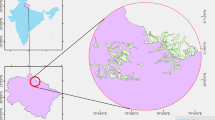Abstract
In lowlands climate-specific processes due to weathering and erosion are dominant, whilst the geomorphology of mountains is dependent on the geologic-tectonic structure, i.e., the energy of erosion that increases according to the vertical. The expression “extremely high mountains” has been established as the extreme of a continuous mountain classification. It has to be understood in terms of geomorphology, glaciology and vegetation. Correspondence of the planetary and hypsometric change of forms is of great value as synthetic explanation. It is confirmed with regard to vegetation, periglacial geomorphology and glaciology. Due to the world-wide reconstruction of the snowline its paleoclimatic importance increases, too. Apart from lower limits the periglacial and glacial altitudinal levels also show zones of optimum development and climatic upper limits in the highest mountains of the earth. According to the proportion of the altitudinal levels a classification as to arid, temperature and humid high mountains has been carried out.
Similar content being viewed by others
References
An Zhongyuan. 1980. Formation and evolution of permanent ice mound on Quing-Zang Plateau. In: J. Glaciology and Cryopedology 2, No. 2, Lanzhou, Pp. 25–30.
Benson, C.S. 1961. Stratigraphic studies in the snow and firn of the Greenland Ice Sheet. Folia Geogr. Danica, 9, Pp.13–37
Bernhardt, F. & Philipps, H. 1958. Die räumliche und zeitliche Verteilung der Einstrahlung, der Ausstrahlung und der Strahlungsbilanz im Meeresniveau. Die Einstrahlung. Abh. Meteor. Hydrol. Dienst DDR Nr. 15, Pp.1–227.
Chijian Mei & Ren Bing-Hui (Hrsg.) 1980. Glaciers in China. Lanzhou Inst, of Glaciology and Cryopedology, Academia Sinica, Shanghai, Pp. 1–177.
Dongus, H.J. 1980. Die geomorphologischen Grundstrukturen der Erde. Stuttgart.
Finsterwalder, S. 1897. Der Vernagtferner. Wiss. Erg. H. z.Z. DÖAV. 1/1.
Furrer, G. 1965. Die Höhenlage von subnivalen Bodenformen. Habil., Pfäffikon, Pp. 1–78.
Furrer, G. & P. Fitze 1970. Die Hochgebirgsstufe — ihre Abgrenzung mit Hilfe der Solifluktionsstufe. GH, 25, Pp. 156–161.
Grunow, J. 1961. Die relative Globalstrahlung, eine Meßzahl der vergleichenden Strahlungsklimatologie. In: Wetter u. Leben 13, Pp. 47–56.
Garleff, K. 1970. Verbreitung und Vergesellschaftung rezenter Periglazialerscheinungen in Skandinavien. — Göttinger Geogr. Abh., 51, Pp. 1–51.
Hagedorn, J. 1969. Beiträge zur Quartärmorphologie griechischer Hochgebirge. Göttinger Geogr. Abh., 50.
Jessen, O. 1950. Fernwirkungen der Alpen. Mit. G. Mü., 35, Pp. 7–67.
Kelletat, D. 1969. Vergesellschaftung rezenter Periglazialerscheinungen im Apenin.—Göttinger Geogr. Abh., 48 Pp.1–114.
Köppen, W. 1923. Die Klimate der Erde. Berlin.
Krebs, N. 1928. Die Ostalpen und das heutige österreich. Stuttgart.
Kuhle, M. 1978b. Obergrenze von Strukturbodenerscheinungen. In: Z. f. Geomorph. NF. 22, Pp. 350–356.
Kuhle, M. 1982a. Der Dhaulagiri-und Annapurna-Himalaya. Ein Beitrag zur Geomorphologie extremer Hochgebirge. — Z. Geomorph., Suppl. Bd. 41, Berlin-Stuttgart, Bd. 1 u. 2: Pp.1–229, Abb. 1-184.
Kuhle, M. 1983. Zur Geomorphologie von S-Dickson Land (W-Spitzbergen) mit Schwerpunkt auf der quartären Vergletscherungsgeschichte. — Polarforschung 53(1): Pp.31–57.
Kuhle, M. 1985a. Glaciation Research in the Himalayas: A New Ice Age Theory. In: Universitas 27(4): Pp. 281–294.
Kuhle, M. 1985b. Permafrost and Periglacial Indicators on the Tibetan Plateau from the Himalaya Mountains in the south tothe Quilian Shan in the north (28–40°N). In: Z.f. Geomorph. N. F., 29,2, Berlin-Stuttgart, Pp. 183–192.
Kuhle, M. 1986a. Die Obergrenze der Gletscherhöhenstufe — Oberflächentemperaturen und Vergletscherung der Himalayaflanken von 5000–8800 m. In: Z. f. Gletschk. Bd. 22, H. 2, Pp. 149–162.
Kuhle, M. 1986b. Die Vergletscherung Tibets und die Entstehung von Eiszeiten. In: Spektrum d. Wiss, Sept. 86, Pp. 42–54.
Kuhle, M. 1987. Glacial, nival and periglacial environments in Northeastern Qinghai-Xizang Plateau.-Journal of Glaciology/Academia Sinica, Lanzhou-Inst, Beijing, Pp. 176–244.
Kuhle, M. 1988a. Die eiszeitliche Vergletscherung W-Tibets zwischen Karakorum und Tarim-Becken und ihr Einfluß auf die globale Energiebilanz. In: Geographische Zeitschrift 76(3): Pp. 135–148.
Kuhle, M. 1988b. Topography as a Fundamental Element of Glacial Systems. A New Approach to ELA-Calculation and Typological Classification of Paleo-and Recent Glaciation. In: GeoJournal 17(4) Kluwer, Dordrecht/Boston/London: Pp. 545–568.
Kuhle, M. 1990. The Cold Deserts of High Asia (Tibet and Contiguous Mountains). GeoJournal 20(3), Pp. 319–323.
Kuhle, M. 1994. Present and Pleistocene Glaciation on the North-Western Margin of Tibet between the Karakorum Main Ridge and the Tarim Basin Supporting the Evidence of a Pleistocene Inland Glaciation in Tibet. GeoJournal 33(2/3), Pp. 133–272.
Lagally, M. 1932. Zur Thermodynamik der Gletscher. Z. f. Glkde Bd. 20, Pp. 199–214.
Lauer, W. 1979. Die hypsometrische Asymmetrie der Päramo-Höhenstufe in den nördlichen Anden. Innsbrucker Geogr. Studien, 5, Pp. 115–130.
Lautensach, H. 1952. Der geographische Formenwandel. Studien zur Landschaftssystematik. Coll. Geogr., 3 Bonn.
Louis, H. 1963. Über Sockelfläche und Hüllfläche des Reliefs. Z. Geomorph. NF. 7, Pp. 355–366.
Maull, O. 1958. Handbuch der Geomorphologie. 2. Auflage, Wien.
Miotke, F.-D. 1981. Formungsprozesse in den eisfreien Gebieten des Victorialandes, Antarktis. In: Würzburger Geogr. Arb., 53, Pp. 195–207.
Pillewitzer, W. 1958. Neue Erkenntnisse über die Blockbewegung der Gletscher. IASH, Publ. Nr. 46, Pp. 429–436.
Schweinfurth, U. 1957. Die horizontale und vertikale Verbreitung der Vegetation im Himalaya. Bonner Geogr. Abhandl., 20.
Troll, C. 1944. Strukturböden, Solifluktion und Frostklimate der Erde. Geol. Rundschau, 34, Pp. 545–694.
Troll, C. 1955. Über das Wesen der Hochgebirgsnatur. JDAV, 80, Pp. 142–157.
Visser, Ph.C., 1934. Benennung von Vergletscherungstypen. Z.f. Glkde, Bd. 21, Pp. 137–139.
Zho Youwu & Guo Dongyin. 1982. Principal Characteristics of Permafrost in China. In: J. Glaciology and Cryopedology 4,1, Lanzhou, Pp. 1–19.
Author information
Authors and Affiliations
Rights and permissions
About this article
Cite this article
Kuhle, M. Altitudinal levels and altitudinal limits in high mountains. J. Mt. Sci. 4, 024–033 (2007). https://doi.org/10.1007/s11629-007-0024-5
Received:
Revised:
Issue Date:
DOI: https://doi.org/10.1007/s11629-007-0024-5




